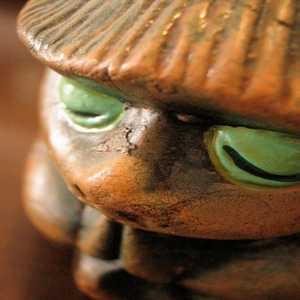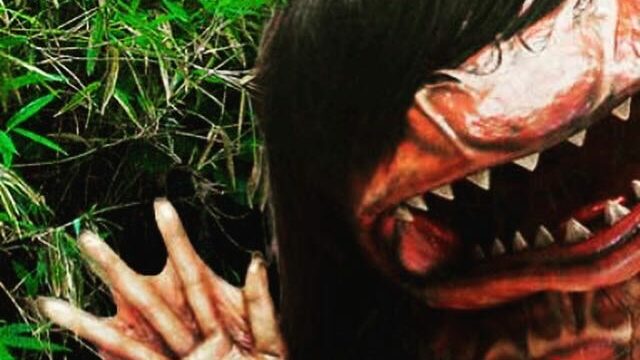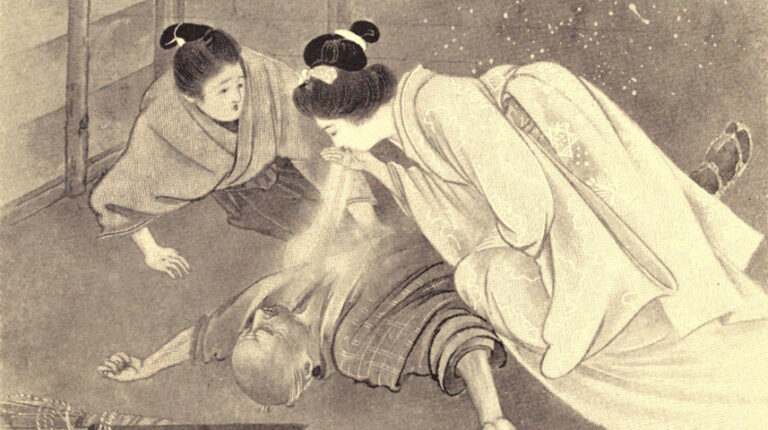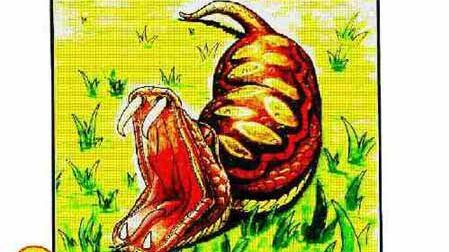Have you ever been sleeping and had a bout of kanashibari (sleep paralysis)? Then during that surreal — most likely frightening — experience, have you ever had what feels like a ghost child crawling on top of you? Or maybe late one night when you’re all alone, you’ve heard an unseen child giggling. Perhaps you’ve heard tiny footsteps running across the floor, or found little footprints on your floor or handprints on the wall. If so, you’ve probably just experienced a have you ever had what feels like a ghost child crawling on top of you? Or maybe late one night when you’re all alone, you’ve heard an unseen child giggling. Perhaps you’ve heard tiny footsteps running across the floor, or found little footprints on your floor or handprints on the wall. If so, you’ve probably just experienced a zashiki warashi (a guest room child). But don’t worry, they’re not bad news. In fact, they’re the bringer of good luck and fortune.
Listen to me talk about this and more on episode 47 of Uncanny Japan.
Hey hey, everyone, I did it. I got two episodes of Uncanny Japan out in February. The weather even cooperated and became all nice and rainy and dreary. That’s not sarcasm. I really mean it. I love this weather.
So today’s topic is a continuation on the last one, episode 46. Remember we were talking about kanashibari, or sleep paralysis? Well, there is something that is often associated with kanashibari. At least I think so, because of this thing that happened to me ages ago.
A Story about Kanashibari (Sleep Paralysis)
I was newly married and living in this old Japanese house we were renting. I had no friends. I mean, I had friends, but they were all living in the States or my friends from university in Japan, had all graduated and gone back to their respective countries. So I had just moved into this house in this small town, in this very old fashioned neighborhood, and I didn’t know anyone my own age.
If I’ve said it once, I’ve said it a hundred times, this was a few years before the Internet began being used in homes, so, yeah, I was feeling pretty isolated. I wasn’t sad though, I spent my days hanging out with my mother-in-law or the elderly women who lived nearby. I also spent a lot of time translating and cooking recipes from this giant cookbook I bought at a local bookstore. When I got tired of that, I watched a bunch of Ge Ge Ge no Kitaro, Hisatsu Shigotonin and Hokuto no Ken.
Anyway, one night for no reason I can think of, I got kanashibari, which was fine. I was kind of used to it. I had learned that if I tried to call out or thrash about, nothing happened and it made it scarier. If, though, I could concentrate on moving a finger or toe, then that tiny movement usually snapped me out of it. Well, that wasn’t working this time. Another odd thing was I couldn’t see, but it felt like someone was in the room. Not my sleeping husband. Someone awake. And then just as soon as I had that thought, someone or something began to climb on me. It was really painful. It felt like something small and heavy was purposefully digging its sharp elbows and knees into my stomach and chest and moving around.
The next day I mentioned the episode to my mother-in-law. She clapped her hands in delight and told me how wonderful that was to hear. I had to reiterate how much it had hurt and how scared I’d been. But she said, no, it wasn’t scary. What had climbed on me last night was a zashiki warashi. A little ghostie thing that looks like a child and visits people at night, sometimes while they sleep. It just wanted to play, she said. It was bringing me good luck. The vibe I got wasn’t good luck. It was more that painting The Nightmare by Henry Fuseli. You know the one of a woman sleeping, arms thrown back over her head, while crouched on her chest and looking straight at the you, is small demon-like figure. Yeah, that’s what it felt like.
Anyway, she begged to differ and that’s when I first heard about the zashiki warashi, sometimes called in English the ‘guest room child’. I’ve since learned they go by zashiki warabe, zashiki bokko, and zashiki kozou as well.
What is a Zashiki Warashi?
There are reports of them all across Japan, with the Tohoku or northeastern area being most famous for them. You’ll find lots of stories about zashiki warashi visitations in Iwate, Aomori, Akita, and Miyagi Prefectures. Especially Iwate.
First off, what does a zashiki warashi look like? Just in case you run across one. Or one runs across you. In general, they look like children, usually thought to be about five or six-years old, although there are reports of both younger and older ones. They can be male or female, or no gender at all, alone or in pairs. It’s also said they have a red face and sport a bob haircut with straight bangs. This in Japanese is sometimes called an okappa cut. They’ll be wearing these old fashioned clothes, like a chanchanko, a kind of Japanese jacket, or kimono, either formal or informal. They’re clothes are usually dark colored or perhaps red. Sometimes even an old fashioned design or striped. You can find images of them looking super cute or super scary.
You might have heard of them from anime and manga. Zashiki warashi have made appearance in titles from Yokai Watch and Onmyoji, to Mononoke and Ge Ge Ge no Kitaro. Although I read through some of the episodes involving them and even though these were written by Japanese authors, some seem ot have taken a few liberties with the original legends. So I’ll stick to the original stories here.
Zashiki warashi are associated with a place, not a person. And not every place has one, but if you do live in a house and one or two or more decide to settle there, it’s considered very good luck for you. It’s thought with them comes prosperity, fortune and happiness. But you have to be careful because they won’t necessarily stay. If you don’t give them the respect they deserve, they’ll leave. Or if you pay too much attention to them, they’ll leave, and if a zashiki warashi leaves your home, you’ll find your luck and wealth will both suddenly decline.
What do Zashiki Warashi Do?
So what else do they do? They pranksters mostly. Remember we talked about the makura gaeshi last time? Well, I’ve read that sometimes the zashiki warashi will also do the pillow switching trick. Sneaking it from under your head while you sleep and placing it at your feet. They’ve been known to leave tiny footsprints in scattered ash or handprints on windows and doors. You might hear them giggle and run across the tatami mat floor. You might hear music or see white orbs floating about the room. All these things are the work of a zashiki warashi.
Types of Zashiki Warashi
Now not all zashiki warashi are created equal. There are some different different kinds.
Choupirako
One is called the choupirako, these beautiful glowing apparitions are also luck and wealth bringers. They’re thought to be the spirits of deceased children of more well off families. For example imagine a wealthy family with only one child. If that child passes away at a young age, an entire room could be dedicated to the deceased boy or girl, a room filled with gifts and toys and kept pristine. A very perfect environment for the choupirako to appear. They are a little high maintenance, though, so you must give them more attention than a regular zashiki warashi.
Hoso Te and Hosote Nagtate
Another kind is called the hoso te (skinny arms) or the hosote nagate (skinny arms, long arms). When sleeping, during the night, these long red slender child’s arms come out to wake you. I found two totally different versions of the myth behind these youkai. One, that they use their long arms to warn you against a disaster, say a flood or tsunami. On another site, however, in Japanese, and what looked to be an old text was a story about the hosote, skinny arms and how they bring bad luck. It was as story about how up north a man was staying in an inn when a pair of long, skinny arms came out from the back of the room, beckoning him. Nothing happened at the time but shortly after he lost his wife in a tsunami. In the same town the arms appeared again in another house, they were attached to a child of three or four and reached out like vines across the room. Later that man’s house was washed away by a flood.
Notabariko and Usutsuriko
There are also a type of zashiki warashi that inhabit the dirt floor in an old home. They’re called notabariko or usutsuriko, or kometsuki, warashi. These little guys aren’t necessarily the happy type.
Let’s get dark for a moment. As in most cultures, way back in the day, some times, some people did this thing called infantacide. One name for it in Japanese was called usugoro. Usu is a mortar and goro means to kill. Now I’ve usually heard this called mabiki. Mabiki is what you do when you plant seeds and a bunch sprout, but since they’re so crowded together, you need to pull out a bunch and let the strong ones thrive. Anyway, usugoro. An usu, a mortar is big and made of wood or stone. The story goes, that was used to get rid of perhaps sickly newborns, or whatever. The story also goes that sometimes they were buried under the dirt floor in a house. These restless spirits would walk around on rainy days (see I told you the weather cooperated today) and bother people.
For example, the notabariko would crawl out from the dirt floor and crawl around, while the usutsuriko would make the sound of a mortar grinding something.
Ryokufusou Inn
Now, another zashiki warashi story. There is an inn called Ryokufusou, in Iwate Prefecture that is quite famous for having one or more zashiki warashi living there. I remember watching TV shows about people who had spent the night there and the experiences they’d had. Hearing sounds, seeing things usually white floating orbs, or feeling things. I also remember thinking, wouldn’t it be cool to make a reservation and spend the night there, just to see what happens. But the waiting list was two years long. And also, the area where the zashiki warashi was supposed to appear was a little spooky. There were hundreds of dolls, toys, especially stuffed animals piled up along the walls, and in the tokonoma alcove, some of them quite old and creepy looking.
It’s said that most of the strange occurrences often happened in a room called the Enju no ma. One legend is that back in the 1300s, during the Nanboku Era, a boy who lived there fell sick. On his death bed he promised to protect his household forever. The zashiki warashi is thought to be his spirit, still protecting. Although sometimes they’re referred to in the plural, so maybe he has since invited some friends.
Anyway, still it was always in the back of my head, Ryokufusou was a place I wanted to visit someday. Then suddenly on the night of October 4th, 2009 the entire inn burned down. Which to me was kind of creepy. I mean, weren’t these little ghosties supposed to be protecting the place? But listening to interviews with the thirty or so people who were staying at the inn that night, they said that everyone escaped unharmed and not only that but the nearby shrine that was dedicated to the zashiki warashi was also completely unharmed. They believe it was the zashiki warashi that helped protect the people, then escaped themselves to the shrine, living there, while the inn was being rebuilt. Once Ryokufusou reopened the zashiki warashi returned. The place is quite gorgeous now and still having otherworldly activity happening.
So there you have it, next time you’re hanging out at home, late at night, all by yourself, and you hear a child giggling in the next room, perhaps running up behind you, or maybe your asleep unable to move, and some curious creature crawls on top of you and pushes and pulls, begging you to play; don’t be afraid. It’s just a zashiki warashi there to increase your fortune and luck. Then again it could be hosote nagate trying to warn you about something. Or something even more insidious. I say trust your gut on this one.
Thank you everyone for listening, supporting me on Patreon, and leaving such lovely reviews. I wanted to mention that this month’s Patreon-only Bedtime Story is called Gonbei the Duck Hunter. Come listen and find out why Gonbei is a jerk. Also, I’ll be putting up a karaage fried chicken recipe soon, too.
Have a wonderful day, wash your hands, stay safe.
Credits
Intro and outro music by Julyan Ray Matsuura






